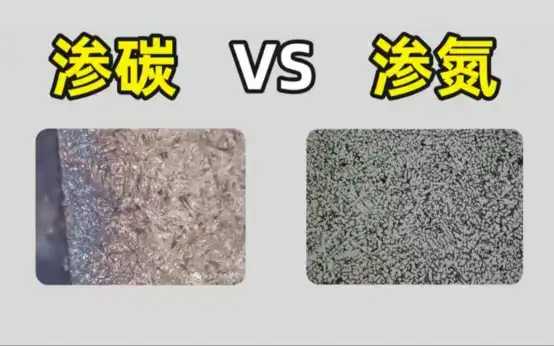
Knowledge
What are the characteristics and differences among carburizing, nitriding and carbo-nitriding? How to choose among them?

In chemical heat treatment, all three methods aim to enhance the hardness, wear resistance, fatigue strength, and other properties of the surface of parts while maintaining the toughness of the core. They all fall under the category of chemical heat treatment. The following provides a detailed explanation of their differences and characteristics:
1. Carburizing
Objective: To infuse carbon atoms into the surface layer of low-carbon steel or low-carbon alloy steel parts, increasing the carbon content on the surface.
Principle: The parts are placed in a carbon-rich medium (such as gases like propane/natural gas, solids like charcoal + carbonate, or liquids like molten cyanide salts) and heated above the austenitizing temperature (typically 900-950°C). Carbon atoms decompose and diffuse into the surface of the steel at high temperatures.
Subsequent treatment: After carburizing, the parts need to undergo quenching to transform the high-carbon surface layer into a high-hardness martensitic structure, while the low-carbon core retains its strength and toughness.
Characteristics:
① Can achieve a relatively deep hardened layer (typically 0.5mm - 2mm or even deeper).
② High surface hardness (HRC 58-65).
③ Mainly used for parts that endure significant contact stress and wear, such as gears, shafts, cams, pins, etc.
④ High processing temperature, resulting in relatively large deformation of the parts.
⑤ Material requirements: Must be low-carbon steel or low-carbon alloy steel (with a carbon content generally below 0.25%).
2. Nitriding
Objective: To diffuse nitrogen atoms into the surface layer of parts (usually special steels containing alloying elements such as Cr, Mo, V, Al, such as 38CrMoAlA, or certain stainless steels and tool steels) to form hard nitrides.
Principle: The parts are placed in a nitrogen-containing medium (the most commonly used is ammonia) and heated to a relatively low temperature in the ferritic or austenitic state (typically 500-580°C). Ammonia decomposes to produce active nitrogen atoms, which diffuse into the surface of the steel and form fine, dispersed hard nitrides (such as AlN, CrN, VN, MoN) with the alloying elements.
Post-treatment: No quenching is required. The nitriding process itself forms a high-hardness compound layer and diffusion layer at a relatively low temperature.
Characteristics:
① Extremely high surface hardness can be achieved (HV 1000-1200 or even higher, equivalent to HRC 68 or above).
② The hardened layer is relatively shallow (typically 0.1mm - 0.6mm).
③ The treatment temperature is low, resulting in minimal part distortion, making it suitable for precision parts.
④ The compound layer formed on the surface has excellent wear resistance, anti-seizing properties, and certain corrosion resistance.
⑤ Significantly improves fatigue strength.
⑥ Mainly used for precision parts that require high hardness, high wear resistance, high fatigue strength, and strict deformation requirements, such as precision gears, crankshafts, camshafts, molds, measuring tools, cylinder liners, etc.
Material requirements: Special nitriding steels containing strong nitride-forming elements (Al, Cr, Mo, V, etc.) are most effective.
3. Carbonitriding
Objective: To simultaneously diffuse carbon and nitrogen atoms into the surface layer of parts.
Principle:
Medium-temperature gas carbonitriding: The most commonly used method. The parts are heated in a mixed atmosphere containing carburizing gas (such as natural gas, propane) and nitriding gas (ammonia) to a temperature slightly lower than that for carburizing (typically 820-880°C). Carbon and nitrogen atoms simultaneously diffuse into the surface austenite of the steel. Quenching is required after the process.
Low-temperature carbonitriding: Sometimes also called soft nitriding or nitrocarburizing. It is carried out in a salt bath or atmosphere containing carbon and nitrogen at the nitriding temperature range (500-580°C). Mainly forms a compound layer rich in nitrogen (ε phase), with a small amount of carbon diffusion. Quenching is not required (or only rapid cooling is needed).
Characteristics:
Compared to carburizing: The treatment temperature is lower, resulting in less part distortion, better hardenability (due to the effect of nitrogen), better wear resistance, and better resistance to tempering softening.
Compared to nitriding: The treatment time is relatively shorter (especially for medium-temperature carbonitriding), and a slightly deeper hardened layer can be obtained (0.2-0.8mm for medium-temperature carbonitriding). The material requirements are not as strict as for nitriding (ordinary carburizing steels can also be used).
Combines some advantages of carburizing and nitriding:
Medium-temperature carbonitriding requires quenching.
Surface hardness is between carburizing and nitriding (HRC 58-63).
Widely used for parts that bear moderate loads, require high wear resistance and certain fatigue resistance, and have certain requirements for distortion, such as gears and shafts in automobiles and tractors.
Vigor has the professional supply chain of special treatments for our metal components of castings, die-forgings and CNC machined parts. If you have any question or parts need to be developed, please feel free to contact us at info@castings-forging.com



